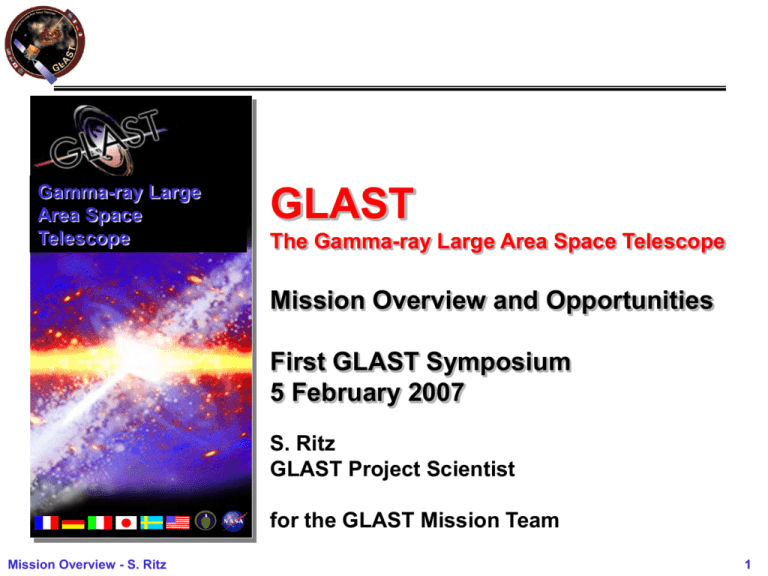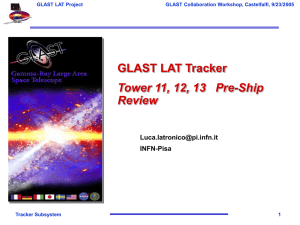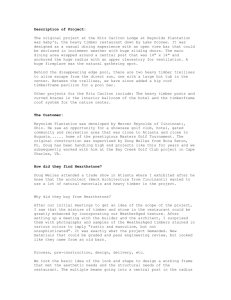GBM Science Requirements Summary
advertisement

Gamma-ray Large Area Space Telescope GLAST The Gamma-ray Large Area Space Telescope Mission Overview and Opportunities First GLAST Symposium 5 February 2007 S. Ritz GLAST Project Scientist for the GLAST Mission Team Mission Overview - S. Ritz 1 GLAST Key Features • Huge field of view – LAT: 20% of the sky at any instant; in sky survey mode, expose all parts of sky for ~30 minutes every 3 hours. GBM: whole unocculted sky at any time. • Huge energy range, including largely unexplored band 10 GeV - 100 GeV • Will transform the HE gamma-ray catalog: Large Area – by > order of magnitude in # point sources – spatially extended sources – sub-arcmin localizations (source-dependent) Telescope (LAT) Two GLAST instruments: LAT: 20 MeV – >300 GeV GBM: 10 keV – 25 MeV Launch: Fall 2007. 565 km, circular orbit 5-year mission (10-year goal) Mission Overview - S. Ritz spacecraft partner: General Dynamics GLAST Burst Monitor (GBM) 2 Mission Overview - S. Ritz 3 EGRET The high energy gamma ray detector on the Compton Gamma Ray Observatory (20 MeV - ~20 GeV), 1991-2000 Mission Overview - S. Ritz 5 GLAST LAT High Energy Capabilities EGRET on GRO firmly established the field of high-energy gamma-ray astrophysics and demonstrated the importance and potential of this energy band. GLAST is the next great step beyond EGRET, providing a huge leap in capabilities: • Very large FOV (~20% of sky), factor 4 greater than EGRET • Broadband (4 decades in energy, including unexplored region E > 10 GeV) • Unprecedented PSF for gamma rays (factor > 3 better than EGRET for E>1 GeV) • Large effective area (factor > 5 better than EGRET) • Results in factor > 30 improvement in sensitivity • Much smaller deadtime per event (27 microsec, factor 4,000 better than EGRET) • No expendables Mission Overview - S. Ritz long mission without degradation 6 Leap in Capabilities: Implications • • • • • • Dynamic Range Frontier; Variability Frontier Whole-sky aperture for transients and variable sources: longterm, evenly sampled lightcurves; dynamic range of emission. Depth Frontier Deepening exposure over whole mission lifetime. Energy Frontier Discovering energy budgets and characteristics of wide variety of cosmic accelerator systems on different scales. – Getting to know 10 - 100 GeV sky – Connecting with TeV facilities: variability, spectral coverage – 7 decades of GLAST GRB energy coverage Spatial Frontier Breaking through to sub-arcmin point-source localizations (source dependent) -- ID the sources; PLUS starting to move beyond point sources: capabilities to resolve spatially, spectrally, and temporally. Timing Frontier Transient and periodic pulse profiles, searches. Measurement Frontier A rich data set to mine, touching many areas of science. Sources we know (AGN, SNR, XRBs, pulsars, PWN, galaxy clusters, solar flares, moon,…) and those awaiting discovery. Even greater multiwavelength/multimessenger needs and opportunities Mission Overview - S. Ritz 7 EGRET Mission Overview - S. Ritz 8 GLAST One-year Service Challenge Simulation red: green: blue: Mission Overview - S. Ritz 0.1-0.4 GeV 0.4-1.6 GeV >1.6 GeV 9 An Important Energy Band Photons with E>10 GeV are attenuated by the diffuse field of UVOptical-IR extragalactic background light (EBL) Opacity (Salamon & Stecker, 1998) opaque only e-t of the original source flux reaches us EBL over cosmological distances is probed by gammas in the 10-100 GeV range. Important science for GLAST! In contrast, the TeV-IR attenuation results in a flux that may be limited to more local (or much brighter) sources. No significant attenuation below ~10 GeV. Mission Overview - S. Ritz A dominant factor in EBL models is the star formation rate -- attenuation measurements can help distinguish models. 10 GLAST Science GLAST will have a very broad menu that includes: • • • • • • • • • Systems with supermassive black holes (Active Galactic Nuclei) Gamma-ray bursts (GRBs) Pulsars XRBs, microquasars Solar physics SNRs, Origin of Cosmic Rays Probing the era of galaxy formation, optical-UV background light Solving the mystery of the high-energy unidentified sources Discovery! New source classes. Particle Dark Matter? Other relics from the Big Bang? Testing Lorentz invariance. Huge increment in capabilities. GLAST draws the interest of both the High Energy Particle Physics and High Energy Astrophysics communities. Mission Overview - S. Ritz 11 Operating modes • • • Primary observing mode is Sky Survey – Full sky every 2 orbits (3 hours) – Uniform exposure, with each region viewed for ~30 minutes every 2 orbits – Best serves majority of science, facilitates multiwavelength observation planning – Exposure intervals commensurate with typical instrument integration times for sources – EGRET sensitivity reached in O(1) days Pointed observations when appropriate (selected by peer review) with automatic earth avoidance selectable. Target of Opportunity pointing. Autonomous repoints for onboard GRB detections in any mode. Sensitivity 100s 1 orbit rms/mean=14%, dominated by SAA effects exposure [cm2s] Mission Overview - S. Ritz 12 Mission Overview - S. Ritz 13 GLAST MISSION ELEMENTS GLAST MISSION ELEMENTS • • GPS msec Large Area Telescope & GBM DELTA 7920H - • Telemetry 1 kbps • GLAST Spacecraft TDRSS SN S & Ku • • S • GN • Schedules Mission Operations Center (MOC) GRB Coordinates Network LAT Instrument Science Operations Center GLAST Science Support Center Schedules Alerts White Sands HEASARC GSFC GBM Instrument Operations Center Data, Command Loads Mission Overview - S. Ritz 14 Operations Phases, Guest Observers, Data • After the initial on-orbit checkout, verification, and calibrations, the first year of science operations will be an all-sky survey. – all GBM data released – LAT data on flaring sources, transients, and “sources of interest” will be released, with caveats (see following slide) – first-year LAT individual photon candidate events initially used for detailed instrument characterization, refinement of the alignment, and key projects (source catalog, diffuse background models, etc.) needed by the community. Individual photon data released at the end of year one. Subsequent photon data released immediately after processing. – burst alerts and repoints for bright bursts – extraordinary ToO’s supported – workshops for guest observers on science tools and mission characteristics for proposal preparation • Observing plan in subsequent years driven by guest observer proposal selections by peer review -- default is sky survey mode. Data released through the science support center (GSSC). Mission Overview - S. Ritz 15 Year 1 LAT Data Releases • • • • Main purpose: trigger MW observations for analysis of year 1 data Throughout year 1 and beyond, high-level data releases continuously: – on any flaring source (flux > 2x10-6 cm-2s-1, E>100 MeV), followed down to factor ~10 lower intensity. Time-binned spectra (or energy-binned light curves) and associated errors. – on approximately 20 sources of interest, time-binned spectra (or energy-binned light curves) or upper limits. List vetted through Users Committee. Posted on GSSC website. – information from GRBs detected both onboard and from groundbased analyses. For GBM bursts with no LAT detections, upper limits provided. At end of year 1, individual photon candidate event info released. All subsequent (year 2 and beyond) individual photon candidate events released immediately after processing. Approximately six months into year 1 (in advance of Cycle 2 proposals) a preliminary LAT source list of high-confidence sources will be released – position, avg flux, peak flux, spectral index, associated errors Mission Overview - S. Ritz 16 GI Opportunities • Annual cycles; typical range $50-$100k/investigation • Cycle 1: – expect to fund ~50 investigations for • analyses of released data • GLAST-related MW observations • GLAST-related theory • GLAST-relevant data analysis methodology • Cycle 2 and onward: – expect to fund ~100 investigations for all of the above plus detailed analyses of LAT photon candidate event lists. – may propose pointed observations, as well as ensured skysurvey periods (expect <20% time on pointed observations) • Tentative Schedule for Cycle 1 (2007) – NRA in ROSES imminent, proposals due in June, Cycle 1 funding starts in December Mission Overview - S. Ritz 17 GLAST Fellows Program Plan • Similar to other observatory Fellows programs • Tentative schedule: – first call for proposals Fall 2007, selections announced early 2008, start in September 2008 • Three new Fellows selected each year, for three-year periods Mission Overview - S. Ritz 18 GLAST Science Support Center (GSSC) • Supports guest investigator program • Provides training workshops • Provides data, software, documentation, workbooks to community • Archives to HEASARC • Joint software development with Instrument Teams, utilizing HEA standards • Located at Goddard • PLEASE DROP BY THE GSSC STATION – check out information, science tools, proposal tools (including sensitivity & spectral estimators, submission forms), provide feedback, ask questions Mission Overview - S. Ritz see http://glast.gsfc.nasa.gov/ssc/ 19 GLAST Users Committee (GUC) • Advises GLAST Project and NASA HQ on NASAfunded Guest Investigator Program and Policies • Meeting at Goddard in November, featuring a betatest of the science tools. • First-year source list vetting. • See http://glast.gsfc.nasa.gov/ssc/resources/guc/ Mission Overview - S. Ritz 20 GLAST Users Committee Members Plus • • • • • • • • • • • Josh Grindlay (Chair) Matthew Baring Roger Brissenden Wim Hermsen Buell Januzzi Don Kniffen Henric Krawczynski Reshmi Mukherjee Luigi Piro Jim Ulvestad Ann Wehrle • • • • • • • • • • • David Band Neil Gehrels Rick Harnden Julie McEnery Chip Meegan Peter Michelson Steve Ritz Rita Sambruna Chris Shrader Kathy Turner Lynn Cominsky http://glast.gsfc.nasa.gov/ssc/resources/guc/ Mission Overview - S. Ritz 21 SWG Activities • Membership includes international representatives from LAT and GBM, along with four Interdisciplinary Scientists (IDS) – Chuck Dermer, Brenda Dingus, Martin Pohl, Steve Thorsett • SWG scientific review of the expected performance (LAT, GBM, Observatory) relative to the Science Requirements. See http://glast.gsfc.nasa.gov/science/swg/feb07/ Mission Overview - S. Ritz 22 MW Info and Coordination • Multiwavelength observations are key to many science topics for GLAST. – GLAST welcomes collaborative efforts from observers at all wavelengths • For campaigners’ information and coordination, see http://glast.gsfc.nasa.gov/science/multi • To be added to the Gamma Ray Multiwavelength Information mailing list, contact Dave Thompson, djt@egret.gsfc.nasa.gov • GI Program will support correlative observations and analysis – See http://glast.gsfc.nasa.gov/ssc/proposals Mission Overview - S. Ritz 23 Summary • GLAST will address many important questions: – How do Nature’s most powerful accelerators work? – What are the unidentified sources found by EGRET? – What is the origin of the diffuse background? – What is the origin of cosmic rays? – What is the high energy behavior of gamma ray bursts? – What is the history of the optical-UV EBL? – What else out there is shining gamma rays? New sources? Are there high-energy relics from the Big Bang? Are there further surprises in the 10-100 GeV energy region? • Huge leap in key capabilities enables large menu of known exciting science and large discovery potential. • Part of the bigger picture of experiments at the interface between particle physics and astrophysics. Mission Overview - S. Ritz 24 Summary • All the parts of GLAST are coming together: – the instruments are beautiful! – observatory integration is nearing completion • Preparation for science and operations in full swing – good connections among all the elements – MW observations are key to many science topics for GLAST. See http://glast.gsfc.nasa.gov/science/multi/ • Looking forward to launch in Fall 2007. Started monthly GLAST news email. Sign up! • Guest Investigator Program starts this year, with many opportunities for GIs. Join the fun! Mission Overview - S. Ritz 25 Backup Slides Mission Overview - S. Ritz 26 Preliminary LAT Year1 Monitored Source Release List (1) Mission Overview - S. Ritz 27 Preliminary LAT Year1 Monitored Source Release List (2) QuickTime™ and a TIFF (LZW) decompressor are needed to see this picture. Mission Overview - S. Ritz 28 LAT Science Requirements Summary(I) Mission Overview - S. Ritz 29 LAT Science Requirements Summary(II) Mission Overview - S. Ritz 30 LAT Science Requirements Summary(III) Mission Overview - S. Ritz 31 GBM Science Requirements Summary (I) Mission Overview - S. Ritz 32 GBM Science Requirements Summary (II) Mission Overview - S. Ritz 33 Observatory Science Requirements (I) Mission Overview - S. Ritz 34 Observatory Science Requirements (II) Mission Overview - S. Ritz 35 Observatory Science Requirements (III) Mission Overview - S. Ritz 36 EGRET All Sky Map (>100 MeV) 3C279 Cygnus Region Vela Geminga Crab PKS 0528+134 Cosmic Ray Interactions With ISM Mission Overview - S. Ritz LMC PSR B1706-44 PKS 0208-512 37 The table below lists the approximate numbers of blazars for which the LAT will measure fluxes and spectral indices to <10% accuracy. State Flux (cm-2 s-1, >100MeV) Time res. No. sources Low < 10-6 24 hr 1000s Medium 10-6 – 10-5 ~12 hr ~100 High > 10-5 ~6 hr ~10 Mission Overview - S. Ritz 38 AGN: Future Prospects • Multiwavelength studies will continue to be the key to understanding how the engines work Mrk501 • Models: same population of HE electrons produces both components Mission Overview - S. Ritz 39 Milkyway Anticenter Region simulation: S. Digel Mission Overview - S. Ritz 40 SNRs and Cosmic Ray Acceleration • GLAST energy range key for proof that Supernova Remnants are the source of the HE cosmic ray protons. Mission Overview - S. Ritz RX J1713.7-3947 41 PWN • • GLAST simulation of Kookaburra region Energy characterization: – lower energy: dominated by pulsed component, relatively poorer PSF – higher energy: better PSF for spatial resolution; determine pulsar cutoffs. Mission Overview - S. Ritz 42 Sources EGRET 3rd Catalog: 271 sources Mission Overview - S. Ritz 43 Sources LAT 1st Catalog? Mission Overview - S. Ritz 44 Features of the gamma-ray sky diffuse extra-galactic background (flux ~ 1.5x10-5 cm-2s-1sr-1) galactic diffuse (flux ~O(100) times larger) high latitude (extra-galactic) point sources (typical flux from EGRET sources O(10-7 - 10-6) cm-2s-1 galactic sources (pulsars, un-ID’d) EGRET all-sky survey (galactic coordinates) E>100 MeV An essential characteristic: VARIABILITY in time! Field of view important for study of transients. In sky survey mode, GLAST will cover the entire sky every 3 hours, with each region viewed for ~30 minutes. Mission Overview - S. Ritz 45








